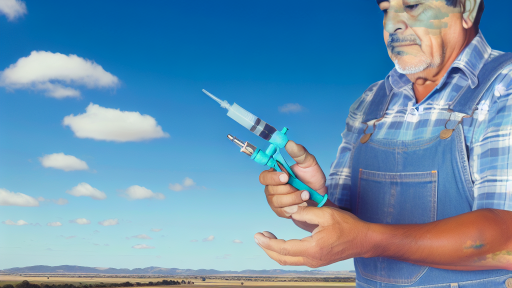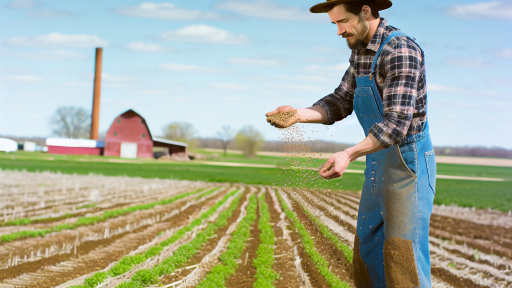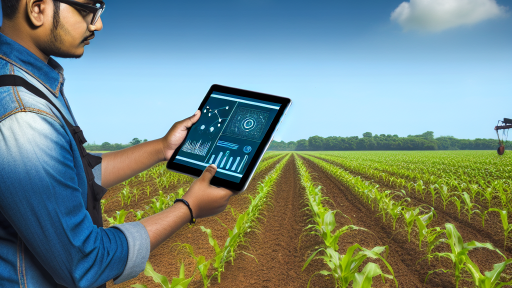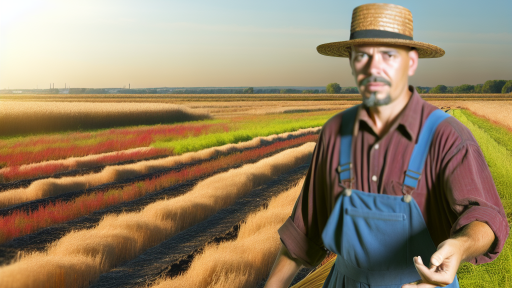Introduction to Smart Farming
Understanding Smart Farming
Smart farming integrates technology into agricultural practices.
This innovative approach enables better crop monitoring and management.
Farmers use data-driven insights to improve yields and efficiency.
Additionally, smart farming addresses sustainability challenges in agriculture.
The Importance of Crop Monitoring
Crop monitoring is crucial for maximizing productivity.
It involves tracking plant health and environmental conditions.
By closely observing crops, farmers can make informed decisions.
This proactive approach helps in pest and disease management.
Moreover, timely interventions can reduce waste and resource usage.
Technological Advancements in Agriculture
Various technologies support smart farming initiatives.
For instance, drones offer aerial imagery for detailed analysis.
Moreover, IoT devices collect real-time data from the fields.
Farmers can monitor soil moisture levels and weather conditions efficiently.
These advancements enable precision farming techniques that enhance productivity.
Benefits of Smart Farming Solutions
Smart farming solutions lead to higher crop yields.
Transform Your Agribusiness
Unlock your farm's potential with expert advice tailored to your needs. Get actionable steps that drive real results.
Get StartedThey allow for better resource management.
Furthermore, these solutions promote sustainable agricultural practices.
Farmers who adopt smart farming technologies can reduce costs.
In addition, they improve overall quality and safety of produce.
Essential Technologies in Smart Farming Solutions for Crop Monitoring
Precision Agriculture Tools
Precision agriculture leverages data and technology for effective farming.
Farmers use GPS systems to enhance field mapping and planning.
Drone technology provides aerial insights into crop health.
Furthermore, farmers can assess soil conditions with remote sensing technology.
Sensor Technologies
Soil moisture sensors play a crucial role in irrigation management.
These sensors help farmers optimize water usage efficiently.
Temperature and humidity sensors also monitor environmental conditions.
Additionally, pest and disease detection systems protect crops proactively.
Data Analytics and AI
Advanced data analytics supports informed decision-making processes.
Farmers analyze historical data to predict future trends.
Artificial intelligence enhances crop yield predictions through machine learning.
This technology also aids in identifying patterns and anomalies.
Mobile Applications in Farming
Mobile apps streamline data collection and management tasks.
Farmers can monitor crop health on the go using these applications.
Moreover, apps facilitate real-time communication with agronomists.
They provide alerts on weather changes and pest outbreaks.
Integration of IoT Devices
The Internet of Things revolutionizes crop monitoring techniques.
IoT devices connect various farming tools and equipment seamlessly.
These devices relay crucial data for smarter farming decisions.
Moreover, they help automate irrigation and fertilization processes.
Showcase Your Farming Business
Publish your professional farming services profile on our blog for a one-time fee of $200 and reach a dedicated audience of farmers and agribusiness owners.
Publish Your ProfileCloud Computing Solutions
Cloud-based platforms enable efficient data storage and access.
Farmers can store large datasets without investing in hardware.
Additionally, cloud computing supports collaboration among agricultural experts.
This technology promotes knowledge sharing and better resource management.
Benefits of Using IoT Devices in Crop Monitoring Systems
Enhanced Data Collection
IoT devices provide real-time data collection for farmers.
This enables the monitoring of crop health continuously.
With accurate data, decision-making becomes easier and more efficient.
Improved Resource Management
These devices help in efficient water usage for irrigation.
Farmers can optimize fertilizer application based on soil conditions.
Additionally, they assist in pest control by monitoring pest populations.
Increased Yield and Quality
IoT devices help in maximizing crop yield through precise monitoring.
Farmers can identify and rectify issues early on.
This proactive measure ensures better crop quality and quantity.
Cost Efficiency
By automating data collection, labor costs reduce significantly.
Agronomists can focus on analysis and strategy instead of manual data entry.
Moreover, resource savings also contribute to overall cost efficiency.
Real-Time Alerts and Notifications
Farmers receive immediate alerts concerning environmental changes.
This includes weather shifts and potential pest outbreaks.
Quick responses to such alerts can safeguard crops effectively.
Integration with Other Technologies
IoT devices integrate seamlessly with other farming technologies.
This includes drones and automated machinery.
The combination enhances overall farm management capabilities.
Analytics and Insights
With continuous data, farmers gain valuable insights.
These insights can guide future crop selections and rotations.
Data analysis helps in understanding long-term farming trends.
Scalability
IoT solutions are highly scalable for farms of all sizes.
Whether small or large, farmers can implement these systems effectively.
As the farm grows, monitoring capabilities can expand accordingly.
Explore Further: Cover Crop Termination Methods for Best Results
Utilizing Drones for Crop Surveillance and Health Monitoring
Overview of Drone Technology in Agriculture
Drones have revolutionized agriculture in recent years.
Farmers increasingly rely on them for monitoring crops.
They provide a bird’s eye view of fields, enabling precise assessments.
This technology allows farmers to make informed decisions quickly.
Benefits of Drone Surveillance
One major benefit is improved crop health monitoring.
Drones can scan large areas in a fraction of the time required by traditional methods.
They use advanced sensors to detect plant stress and deficiencies.
Additionally, drones can identify pest problems early on.
This proactive approach reduces crop damage significantly.
Types of Drones Used in Crop Monitoring
Several types of drones are available for agricultural use.
Fixed-wing drones cover large distances efficiently.
Showcase Your Farming Business
Publish your professional farming services profile on our blog for a one-time fee of $200 and reach a dedicated audience of farmers and agribusiness owners.
Publish Your ProfileQuadcopter drones provide detailed images for smaller plots.
Multispectral drones capture data beyond visible light.
This helps farmers assess crop health by analyzing plant reflectance.
Practical Applications of Drones in Farming
Drones serve multiple purposes in crop monitoring.
They collect data for precision agriculture, enhancing yield and quality.
Farmers can use them for mapping and geospatial analysis.
Furthermore, they aid in monitoring irrigation and soil health.
This capability ensures strategic resource allocation throughout the season.
Future Trends in Drone Use for Agriculture
The future of drone usage in agriculture looks promising.
Continuous advancements in technology enhance their capabilities.
Farmers will likely embrace autonomous drones for routine monitoring.
Additionally, AI and machine learning integration will improve forecasting.
Such innovations will help farmers adapt to changing climate conditions.
Find Out More: Choosing the Right Hydroponic Setup
Data Analytics and Machine Learning in Predictive Crop Monitoring
The Role of Data Analytics
Data analytics is transforming crop monitoring strategies.
This process involves collecting vast amounts of agricultural data.
Farmers can use this information to identify trends in crop performance.
Turning raw data into actionable insights enhances decision-making.
As a result, analytics allows farmers to optimize their yield potential.
Benefits of Predictive Analysis
Predictive analysis empowers farmers in several ways.
First, it enables early detection of crop diseases.
This proactive approach minimizes crop losses and maximizes profits.
Furthermore, predictive models forecast weather patterns accurately.
Farmers can adjust planting and harvesting schedules accordingly.
Integration of Machine Learning
Machine learning algorithms enhance predictive accuracy significantly.
These algorithms analyze historical data to predict future outcomes.
For instance, they can assess soil health and moisture levels.
This capability allows for personalized crop management strategies.
Additionally, machine learning minimizes the guesswork in farming practices.
Real-World Applications
Several companies are leading the way in smart farming solutions.
AgriTech Innovations creates adaptive analytics platforms.
This platform provides farmers with real-time monitoring tools.
FarmWise employs robots equipped with machine learning capabilities.
These robots assist in precise farming operations, reducing manual labor.
The Future of Crop Monitoring
The future of crop monitoring appears bright with technology.
Increased connectivity and data-sharing will drive innovation.
Moreover, the integration of Internet of Things (IoT) devices will expand capabilities.
Farmers will gain deeper insights into their fields continuously.
This progress will result in sustainable, high-yield farming practices.
Gain More Insights: How to Boost Soil Fertility Naturally on Farms
Showcase Your Farming Business
Publish your professional farming services profile on our blog for a one-time fee of $200 and reach a dedicated audience of farmers and agribusiness owners.
Publish Your Profile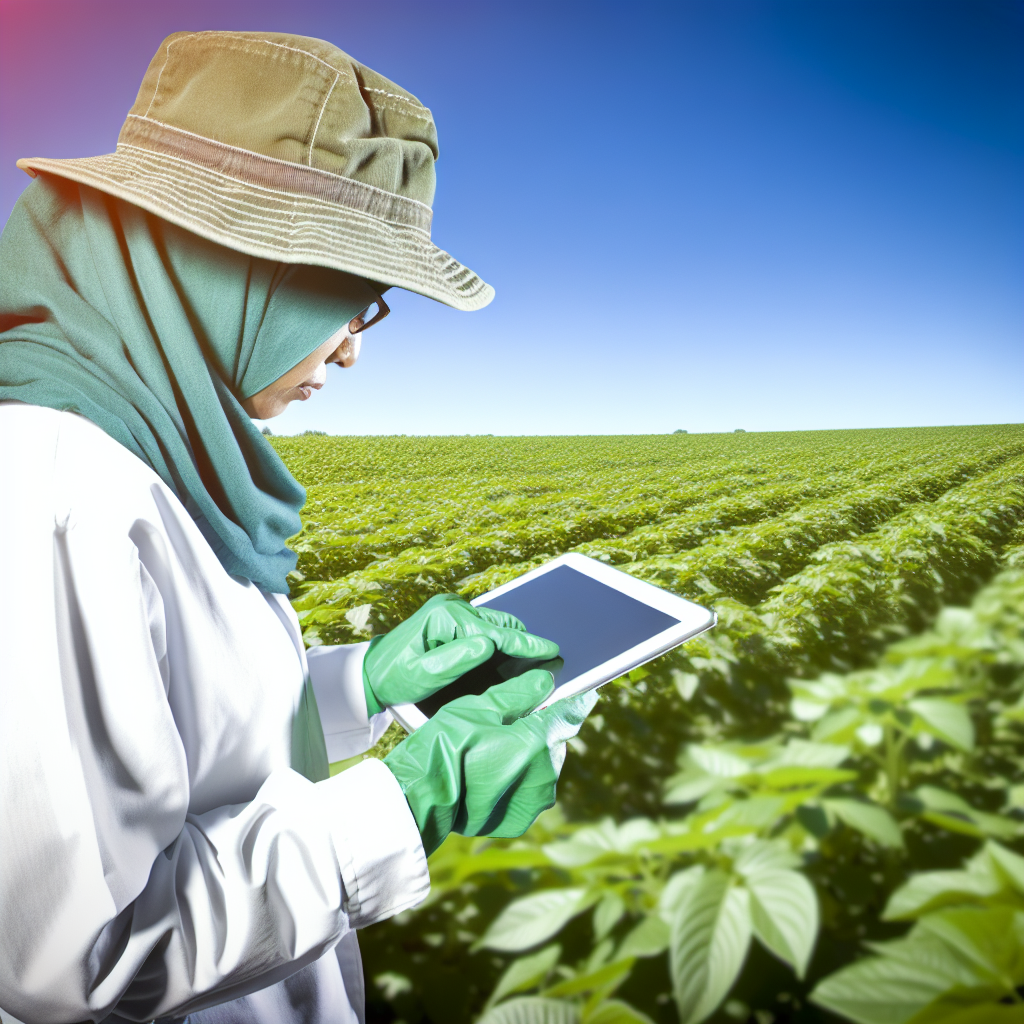
Case Studies of Successful Smart Farming Implementations in Crop Monitoring
Innovative Solutions at Green Acres Farm
Green Acres Farm recently integrated IoT sensors throughout its fields.
These sensors collect data on soil moisture and temperature.
Farmers access this information remotely via a mobile app.
This approach enhances decision-making during critical growth periods.
As a result, crop yield increased by 15% the first season.
Harvest Innovations in Precision Agriculture
Harvest Innovations developed a drone technology for aerial monitoring.
This technology captures high-resolution images of crops.
Farmers analyze these images to assess crop health efficiently.
Consequently, they can identify issues like disease or pests early.
Therefore, timely interventions lead to reduced crop loss.
Collaboration with EcoFarm Technologies
EcoFarm Technologies partnered with local farmers to introduce smart irrigation systems.
These systems utilize data analytics to optimize water usage.
Farmers can adjust irrigation schedules based on real-time weather conditions.
This collaboration resulted in a 30% reduction in water consumption.
Additionally, crops showed improved growth rates and resilience.
Impact of AI at Valley Crest Farm
Valley Crest Farm implemented AI-driven analytics for crop monitoring.
Machine learning algorithms predict crop performance and yield.
Farmers receive actionable insights tailored to their specific crops.
This technology helped reduce input costs by 20% within a year.
Moreover, it improved overall farm management efficiency.
Community Benefits from Smart Farming
Smart farming promotes sustainability within agricultural communities.
It helps reduce chemical usage through precise application techniques.
Consequently, this approach enhances soil health and biodiversity.
Furthermore, local economies benefit from increased agricultural productivity.
Smart farming represents a promising future for sustainable agriculture.
Discover More: Integrating AI Solutions In Crop Analytics
Challenges and Barriers to Adopting Smart Farming Solutions
Technological Limitations
Many farmers face technological limitations when considering smart farming solutions.
Access to reliable internet remains a significant barrier in rural areas.
Moreover, some farming communities lack the necessary infrastructure for advanced technologies.
As a result, it becomes challenging to utilize precision agriculture effectively.
Financial Constraints
Financial constraints play a crucial role in limiting smart farming adoption.
High initial investment costs deter many small farmers from upgrading their systems.
Additionally, continuous costs for maintenance and software updates can be prohibitive.
Consequently, some farmers struggle to see the return on investment.
Knowledge Gaps
Knowledge gaps also hinder the adoption of smart farming practices.
Many farmers lack training in using advanced technologies.
Without proper education, they may not understand the benefits fully.
This lack of awareness can lead to resistance against implementing new systems.
Regulatory Issues
Regulatory issues complicate the integration of smart farming solutions.
Compliance with local agricultural regulations can be overwhelming.
Showcase Your Farming Business
Publish your professional farming services profile on our blog for a one-time fee of $200 and reach a dedicated audience of farmers and agribusiness owners.
Publish Your ProfileMoreover, rules frequently change, creating uncertainty for farms investing in new technologies.
This uncertainty can stall progress towards modernizing agricultural practices.
Social Acceptance
Social acceptance of smart farming technologies varies widely among communities.
Some farmers may feel skeptical about new methods and their effectiveness.
Additionally, traditional practices often dominate the agricultural landscape.
Consequently, it may take longer for smart farming to gain widespread acceptance.
Future Trends and Innovations in Crop Monitoring Technologies
Integration of Artificial Intelligence
Artificial intelligence transforms crop monitoring processes.
Farmers utilize AI algorithms for data analysis.
These algorithms help in predicting crop yields.
Moreover, AI enhances precision agriculture methods.
This integration simplifies decision-making for farmers.
Utilization of Drones and Aerial Imaging
Drones provide real-time aerial imagery of fields.
This technology monitors crop health effectively.
Additionally, drones facilitate faster data collection.
Farmers gain insights into their crops from above.
This enhances overall farm management and strategy.
Advancements in Sensor Technology
Modern sensors offer improved soil and moisture tracking.
This technology allows for precise irrigation management.
Farmers access real-time data on environmental conditions.
Consequently, they can optimize resource usage.
Moreover, sensors enhance monitoring of pest populations.
Adoption of IoT Solutions
The Internet of Things connects various farming tools.
This interconnectedness improves data sharing and analysis.
Farmers monitor crops remotely through mobile applications.
Additionally, IoT devices automate many farming tasks.
This trend increases efficiency across the agricultural sector.
Sustainability Through Data-Driven Insights
Data analytics promote sustainable farming practices.
Farmers can make informed decisions for crop management.
This reduces environmental impacts significantly.
Furthermore, sustainable practices enhance soil health.
Ultimately, this trend supports long-term agricultural viability.
Additional Resources
Agriculture Innovation: 10 Tech Trends to Watch in 2023 …
EOSDA Crop Monitoring: Farm Software For Agricultural Sector

